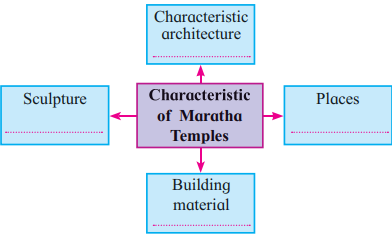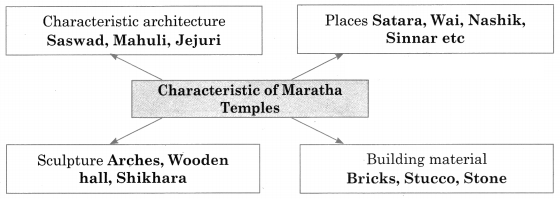Swarajya to Empire (Maratha Period)
Q.1 (A) Choose the correct alternative and write the complete sentences.
(1) _____ is known as the Father of Indian Navy.
(a) Chhatrapati Shivaji Maharaj
(b) Chhatrapati Sambhaji Maharaj
(c) Chhatrapati Rajaram Maharaj
(d) Chhatrapati Shahu Maharaj
Answer: (a) Chhatrapati Shivaji Maharaj
(2) The Pathans from Afghanistan had settled in ______ , the province at the foothills of the Himalayas.
(a) Varanasi (b) Mathura
(c) Ayodhya (d) Delhi
Answer: (c) Ayodhya
(3) Chhatrapati Sambhaji Maharaj wrote the Sanskrit text _____ .
(a) Nayikabhed (b) Budhabhushan
(c) Nakhshikh (d) Satasattka
Answer: (b) Budhabhushan
(B) Find the incorrect pair from set B and write the correct ones.
| Set ‘A’ | Set ‘B’ |
| (a) Naik-Nimbalkar Wada | Vathar |
| (b) Nana Phadanvis Wada | Menavali |
| (c) Kalaram Temple | Jejuri |
| (d) Mohiniraj Temple | Nevase |
Answer: (c) Kalaram Temple – Nashik
(C) Write the name.
(1) He was the Chief of the intelligence network of Shivaji Maharaj – Bahirji Naik
(2) He assisted in the provincial affairs – Deshmukh
(3) Leader of the Rohillas – Najib Khan
Q.2 Complete the following concept map.
Answer:
Q.3 Explain the statement with reasons.
(1) Shahajiraje is known as the visionary of Swarajya.
Answer: Shahajiraje is regarded as the visionary of Swarajya because he aspired to establish an independent Maratha state free from foreign rule. As a prominent sardar in the Nizamshahi and later Adilshahi courts, he gained administrative and military experience, which he used to nurture the idea of self-governance. He sent his son Shivaji Maharaj and wife Veermata Jijabai to Pune, entrusting them with his Jahagirs and the vision of Swarajya. His strategic foresight and ambition laid the groundwork for Shivaji Maharaj to establish and expand Swarajya, making Shahajiraje the visionary behind this movement.
(2) Chhatrapati Shivaji Maharaj built the naval force.
Answer: Chhatrapati Shivaji Maharaj built a naval force to establish control over the sea and protect Swarajya’s trade and coastal regions. Recognizing the importance of maritime power, he sought to counter threats from foreign powers like the Portuguese and Siddis. He collaborated with Portuguese shipbuilders, Rui Leitao Viegas and Fernao Viegas, to construct warships and trained local fishermen to build a fleet. By 1675 C.E., his navy had 400 ships, enabling him to control coastal trade routes and conduct operations, such as the sack of Surat. His foresight in creating a navy earned him the title “Father of the Indian Navy.”
(3) Chhatrapati Shivaji Maharaj charged heavy duty on the salt imported from the Portuguese territory.
Answer: Chhatrapati Shivaji Maharaj imposed heavy duties on salt imported from Portuguese territory to protect and promote local industries in the Konkan region. The imported salt was undermining the local salt trade, which was vital for the economic well-being of Swarajya. By increasing the cost of imported salt through heavy duties, he discouraged its import, thereby boosting the sale of locally produced salt. This policy reflected his commitment to fostering economic self-sufficiency and safeguarding the livelihoods of local traders and producers.
Q.4 Write short notes.
(1) Maratha Art
Answer: Maratha art flourished during the Maratha period, particularly in miniature paintings, murals, and performing arts. Miniature paintings were created on manuscripts like pothis, pattachitra, and patrikas, illustrating texts such as Bhagvat Gita, Dnyaneshwari, and Shivaleelamrut. These paintings featured themes like Dashavatara, ragamalas, and royal processions, using vibrant colors like red, green, and yellow. Murals adorned wadas and temples, depicting mythological stories from Ramayana and Mahabharata, as well as contemporary social scenes. Performing arts, including keertan, bhajans, powadas, and lavani, were popular, with Shahirs like Adnyandas and Tulsidas composing ballads to inspire heroism. Dance forms like lavani and koli dance also thrived, reflecting the cultural richness of the period.
(2) Maratha Architecture
Answer: Maratha architecture was characterized by the construction of forts, wadas, temples, and civic structures. Chhatrapati Shivaji Maharaj prioritized building hill and sea forts, such as Sindhudurga, to strengthen Swarajya’s defense. Wadas, like Vishrambaug and Nana Phadanavis wada, were built with stone and brick, featuring multiple courtyards, wooden pillars, and motifs like parrots and peacocks. During the Peshwa period, temple construction flourished, with examples like Kalaram and Sundarnarayan in Nashik, built in stone with intricate sculptures and star-shaped designs. Temples often included arches, sabhamandapas, and shikharas made of brick and stucco. Stone deepmalas, ghats, and chhatris were also notable, with extensive ghats built along rivers in Nashik, Wai, and Menavali, reflecting the architectural grandeur and urban development of the Maratha period.



Leave a Reply